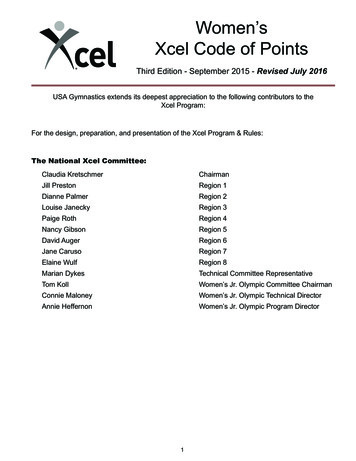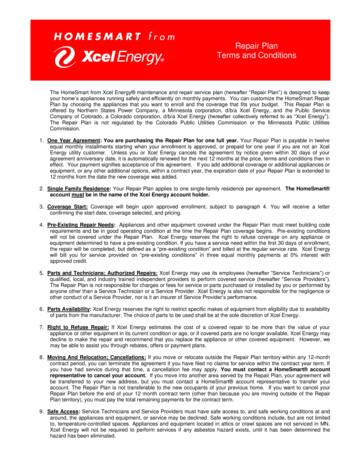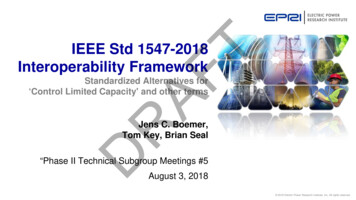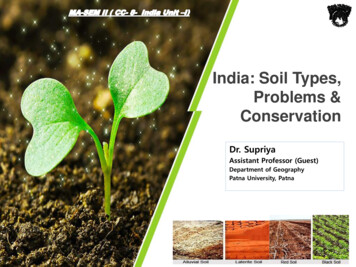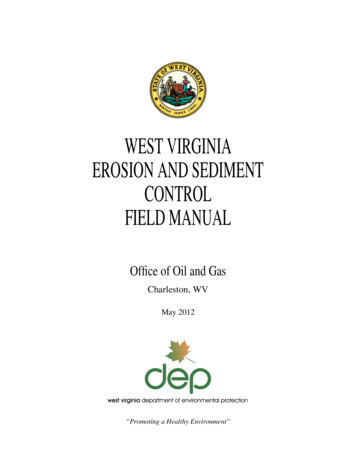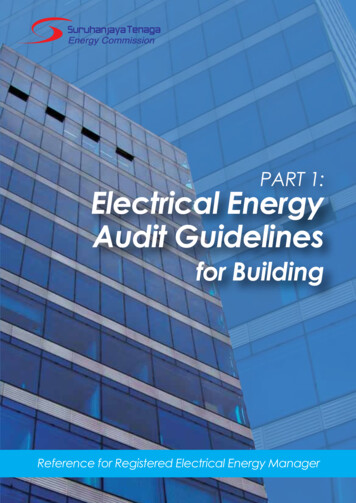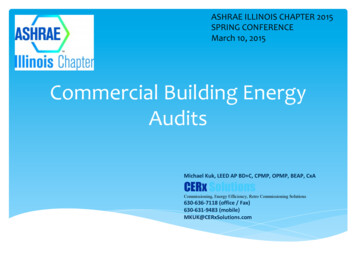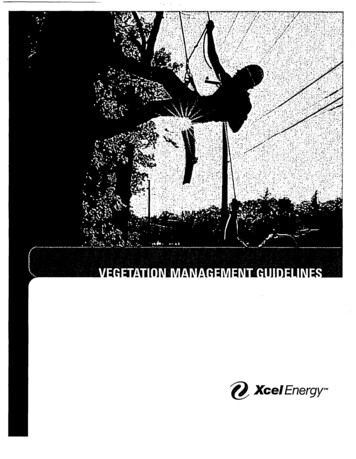
Transcription
---nj.4(ILTI.I.,I'fI uUilI of 'EjMI NJ 9 IL'IXcelEnergysu
I I.6--SSInAbout this Information .2Safety Policy .2OSHA Requirements (1910.269).3ANSI Requirements (Z-133.1-2000).3State Requirements .3Section 1: General Line Clearance.441.1 - Why Electric Utilities Are Required To Perform The Work.1.1.1 - National Electric Safety Code (NESC) Requirements.41.1.2 - Public Utilities Commision (PUC) and Public Service.4Commision (PSCQTarrifsSection 2 Integrated Vegetation Management (IVM).2.1- General Philosophy2.2 - DangerTree Mitigation2.3 - Work Quality Guidelines.77.2.3.1 ANSIA-300 - 2001 .782.3.2 Pruning.2.3.3 Removal .9Section 3: Distribution Line Clearance .103.1 Clearance Guidelines3.1.1 Definition of ConductorTypes .103.1.2 Rights ofWay/Easements/Fee-Owned Rights of Way .113.2 Work Descriptions.13.2.1 Routine Maintenance/Scheduled Work .113.2.2 External and Safety Zone Requests .113.2.3 Internal Requests.123.2.4 Emergency/Storm Response.12Section 4: Transmission Line Clearance .144.1 - General Guidelines and Program Philosophy .144.1.1 Minimum Clearance Guidelines .164.2 - Work Descriptions .204.2.1 Routine Maintenance /Scheduled Work .204.2.2 External Requests and Safety Zone Requests .214.2.3 Internal Requests .214.2.4 Emergency/Storm Response .22Section 5: Overhead Safety Inspection Program .23Section 6: Landscape Maintenance & Weed Abatement .25Section 7: Miscellaneous Vegetation Management .267.1 -Vegetation Management System (VMS) .267.2 - Herbicide Guidelines .267.3 - Special Conditions Documents .277.4 - Avian Protection .277.5 - Responsible Tree Planting .2877
v., -- ,Ia--I, .'. -! . , . -o -.ABOUTTHIS INFORMATION & SAFETY POLICY'A guide, not anabsolute rule:'ABOUTTHIS INFORMATIONThe following information is intended as a guide for contractors performingvegetation management services.Vegetation management includes the servicesof distribution and transmission line clearance, overhead safety inspectionprogram, landscape maintenance and bare-ground weed abatement. Regardlessof the service performed, every work site has its own safety and workrequirements.Note:This information addresses reliability at Xcel Energy facilities and is notintended for use as personal safety guidelines. Contractors are responsible fordeveloping and following their own safety procedures.Contractors who are performing vegetation management services are requiredto have a copy of this information with them in the field. Those performingline clearance activity are also required to have the book PruningTrees NearElectric Utility Lines by Dr.Alex Shigo on each truck/work location at all times.Safety StatementThere is no job wedo norserviceweperform so urgent thatwe cannot taketime and use thenecessary equipmentto do it safely.IThis information supersedes all previous manuals and guidelines for line clearanceand vegetation management work at Xcel Energy including Northern States PowerMinnesota, Northern States Power Wisconsin, Public Service Company of Colorado, andSouthwestern Public Service Company.April 2005SAFETYAll contractors performing vegetation management work on or near XcelEnergy facilities or rights of way shall follow approved safety guidelines andprocedures.AIl contractors performing work for Xcel Energy shall comply withall applicable governmental safety and health regulations, and the safety andhealth provisions of their contracts.There are two important standards for tree worker safety in the United States,OHSA 1910.269 and ANSI Z133.1-2000. Contract line clearance tree workersmust meet the requirements of these standards as well as any other applicablefederal, state or local laws, codes, or regulations.OSIIA Requirements (1910.269)OHSA 1910.269 is the Occupational Safety and Health Administration's verticalstandard pertaining to the generation, transmission and distribution ofelectricity. A specific section of OHSA 1910.269 requires that everyoneperforming tree work in proximity to electric hazards must be qualified andtheir training has to be documented.[2]
ANSI Requirements (Z-133.1-2000)ANSI Z-133 is the American National Standard forArboricultural OperationsPruning, Repairing, Maintaining, and Removing Trees, and Cutting Brush- SafetyRequirements. It has the force of law because it is the document an OSHAcompliance officer would reference when identifying safety violations ofemployees engaged in tree work. Therefore, it is considered the definitivesafety standard for arboricultural operations.In short,ANSI Z-133 defines an electric hazard to exist anytime a tree worker,tool, tree or any other conductive object is closer than 10 feet from anenergized conductor with a voltage of 50,000 volts or LESS. From this 10-footbaseline, 0.4 inches of required clearance is added for every 1,000 volts abovethe 50,000-volt baseline. ANSI Z-133 provides tables that outline minimumapproach distances for both qualified and non-qualified tree workersbased on voltage and elevation.Contractor managers are required to provide ANSI Z-133 minimumapproach distance tables to their employees.State RequirementsColorado: Colorado Revised Statutes Article 2.5- High Voltage Power linesSafety Requirements. Only qualified employees of an electric utility canperform any activity that may bring an individual or equipment within 10 feetof high voltage (lines in excess of 600 volts) overhead lines. Contractorsworking directly for the utility are considered qualified. Non-qualifiedemployees or individuals must contact the appropriate utility to makearrangements for safe activity.Texas: Texas Statutes Chapter 752- High Voltage Power lines. Only qualifiedemployees of an electric utility can perform any activity that may bring anindividual or equipment within 6 feet of high voltage (lines in excess of 600volts) overhead lines. Contractors working directly for the utility arcconsidered qualified. Non-qualified individuals must contact the appropriateutility to make arrangements for actions to be taken to mitigate the hazard.All contractors must be aware at all times of the nature and characteristicsof the Xcel Energy electric and/or gas facilities to be worked before any workbegins. Contractors need to understand that electric facilities must remainenergized during the performance of work unless special arrangements aremade with an authorized Xcel Energy representative.[3]
The following procedurespertain to contractorsperforming vegetationmanagement work for Xcel Energy:* The contractor shall obtain full information as to the voltage of its circuitsand minimum approach distances before starting the work.* The contractor shall at all times conduct work in a manner to safeguardthe public from injury and property from damage.* The contractor must use all necessary protection for its employees and thepublic, and guard against interference with normal operation of the circuits. If,in the judgment of the contractor's general foreman/supervisor, it is toohazardous to prune or remove trees with the circuits energized, the contractormust contact an authorized Xcel Energy representative(s). If appropriate, XcelEnergy will provide the necessary protective materials or de-energize circuitsto ensure the safe pruning or removal of the tree(s). Should the contractorknock down or come into contact with Xcel Energy conductors (powerlines), the contractor must notify Xcel Energy immediately and take thenecessary protective measures.AII contractor-caused electric serviceinterruptions are subject to repair at the contractor's expense.* In the event a contractor becomes aware of any dangerous, broken, looseor faulty Xcel Energy line facilities in the normal course of its line dearanceperformance, the contractor shall promptly advise Xcel Energy as to the exactequipment location(s) and nature of the condition found in accordance withthe Overhead Safety Inspection Program. (See section 5, OHSI program).* Any contractor personnel entering substation equipment yards must bequalified employees (OSHA 1910.269) and must have attended XcelEnergy sponsored substation hazard awareness training. Contractorpersonnel must notify dispatch/area control prior to entering anysubstation, must lock the gate behind them while in the substation, notifydispatch/area control when leaving the substation, and must close andlock the gate behind them.Colorado Substations: Either 303-273-4813 or 303-278-4703Texas North Dispatch: 806-796-3255Texas South & New Mexico Dispatch: 806-796-3250Minnesota Metro East: 651-229-2575Minnesota Metro West: 612-321-7435Greater Minnesota, South Dakota, and North Dakota: 612-321-7434Wisconsin: 715-839-2618[4]
r.GENERAL LINE CLEARANCE1.1 -WHY ELECTRIC UTILITIES ARE REQUIRED TOPERFORM THE WORKState regulatory entities such as Public Utility Commissions (PUC) and PublicService Commissions (PSC) require electric utilities to maintain its electricalsystems in accordance with the National Electric Safety Code (NESC). TheNESC generally requires the trimming or removal of interfering trees.In addition, trees are a major contributor of electric service interruptions,nationwide. Trees cause outages in two ways, mechanical and electrical.Mechanical damage refers to entire trees or portions of trees failing andphysically damaging facilities (knocking down wires, poles, etc.). Because treescan be conductive, electrical outages can also occur. These interruptions arecaused when a portion of a tree becomes a short-circuit path for electricity toflow causing a protective device to operate and stop the flow of electricity.Therefore, trees must be maintained an adequate distance from the conductorsin an attempt to prevent interruptions of electric service.1.1.1 NationalElectric Safety Code (NESC) RequirementsThe National Electric Safety Code,TreeTrimming Section 218.A.1 states:Trees that mayh interfere with ungroundedstipply conductors shouldbe trimmed or removed.Note:Nonrmal tree growth, the combined movement of trees andconductors under adverse weather conditions, voltage, and saggingof conductors at elevated temperatures are among the factors to beconsideredin determining the extent of trimming required.1.1.2 Public Utilities Commission (PUG) and Public ServiceCommission (PSC) TariffsTariffs and agreements with various state regulatory entities give utilitycompanies and their contractors the ability to enter private property formaintenance purposes regardless of the existence of an easement orprescriptive rights.Specific documents include:Colorado: Tariff R43,Access For Company's EmployeesTexas: Section V,Sheet V-1i ,Access To PremisesNew Mexico: Section lO,AccessTo Premises[5]
f.II'41,-.pITOklahoma: Sheet 47,Access To PremisesKansas: Sheet 27,AccessTo PremisesMichigan: Sheet 20,AccessTo PremisesMinnesota: No. 2, Section 1.3, Sheet 6-3,Access To Customer PremisesNorth Dakota: Section 1.3, Sheet E 78,Access To Customer PremisesSouth Dakota Section 1.3, Sheet 6-3,AccessTo Customer PremisesWisconsin: Sheet E 90, Schedule Ex-22,Access To Customer Premises[6]
IiI I I:.teI& sINTEGRATED VEGETATION MANAGEMENT (IVM)2.1- GENERAL PHILOSOPHYIVM is a data-driven, progressive system of information gathering utilized tobest plan and complete work, including follow-up auditing, to ensure thedesired results are achieved. It involves the use of various types of vegetationmanagement treatment including the removing, pruning, mowing of vegetationand the treatment of vegetation with chemicals. The overall goal of a utilityIVM program is to develop site-specific, environmentally sensitive, cost-effectiveand socially responsible solutions to vegetation control near electric andnatural gas facilities.2.2 - DANGERTREE MITIGATIONTrees that are located off the right-of-way that have a present an unacceptablerisk of line interference before the next maintenance cycle are classified asdanger trees, and should be cleared.Conditions could include but are not limited to the following:* Dead or dying trees* Leaning trees* Weak branches* Shallow root system* Root failure* Internal decay* Canker or canker root2.3 -WORK QUALITY GUIDELINES2.3.1 ANSI A-300 - 2001The American National Standard Institute's A-300 standard presents performancestandards for the care and maintenance of trees, shrubs, and other woody plants.The standard is intended as a guide for federal, state, municipal, and privateauthorities including property owners, property managers, and utilities.Whenever possible and practical, contractor tree workers are expected toadhere to this standard when pruning trees near electric facilities.Dr.Alex Shigo's yellow booklet titled Pruning Trees Near Electric Utility Linesprovides a good working summary of the principals included in ANSI A-300.Contract tree workers are expected to have a copy of this booklet in the fieldfor reference purposes.[7]
00:.-M 2.3.2 PruningTree pruning is the selective removal of branches that are not an adequatedistance from the primary line, or that will grow too close to the power linebefore the next maintenance cycle. Secondary, street light and service wiresare not routinely trimmed for clearance unless overbuilt primary exists. Inaddition, secondary or street light wires may be trimmed if major interference,such as broken limb, exists.Tree pruning is done to provide adequate clearance from Xcel Energy facilitieswhile making proper cuts. If practical, trimming methods will be based onprocedures and examples set forth by ANSI A300. As a general rule, treesshould be pruned to improve or re-establish the clearance provided fromprevious tree maintenance performed.Remove or shorten dangerous limbs, such as those overhanging wires that havea high potential for breaking or bending into Xcel Energy conductors due toice, snow or wind loading. Be aware of the possibility of included bark at thebranch bark ridge.Some factors to consider when pruning include:* The growth rate of the tree species (how fast the branches grow back)* The wood strength of the tree species (the chance of the branch breakingunder the load of strong wind, snow, or ice)* The voltage conducted by the line and the line's construction (the higherthe voltage, the greater the clearance required).* Number of customers exposed* Critical customers (hospitals, etc)* General public safety (existence of tree houses, public places, climbabilityetc.)Vegetation ScreensWThere required by federal, state and/or local laws or regulations, screens oftrees may be left on the right-of-way so the natural tree line is not interrupted.[8]
I-23.3 RemovalTree removal is the selective clearing of entire trees and brush at ground levelthat create an unacceptable risk of interference with the electrical conductors.Contractors will consult their Xcel EnergyVegetation Management representativefor specific removal criteria for the area in which they are working.Some factors to consider when determining if removal is appropriate include:* Remove all tall-growing trees within the width of the right-of-way that fitthe removal criteria for that geographic territory.* Remove all tall-growing brush that has the potential to grow into theconductor.* All trees and brush should be cut as close to the ground as practical.* 'Thenever possible, stumps should be treated with herbicide to prevent resprouting.* Remove all second growth from stumps cut on previous pruning cycles.* Remove all trees that present an unacceptable risk to Xcel Energyfacilities. (See DangerTree Section 2.2)* Keep all poles, guy wires and switch grates clear of vegetation.Trees are not removed from the vicinity of secondary, streetlight and servicewires. Customers that want to have trees cleared from these conductors ontheir own may request that the conductor be de-energized by Xcel Energy forprivate removal by calling 1-800-895-4999.[9]
1,- - .- a roN.'.DISTRIBUTION LINE CLEARANCE3.1 - CLEARANCE GUIDELINESXcel Energy's clearance guidelines are based on local tree growth rates, specificto individual trees on specific circuits. Specific clearances are determinedbased on species growth rates, as well as line voltage, construction of facilities,electric reliability performance and other factors listed below.Therefore, each individual tree needs to be assessed to determine adequateclearance required from the conductor to prevent service interruption, damageto Xcel Energy facilities, and threats to public safety. Xcel Energy expectsqualified line-clearance tree workers to use their professional judgment todetermine what these clearances will be in each situation, based on theproposed maintenance cycle for the circuit on which they are working.Contractors shall not rely on the accuracy of the line circuit or feeder maps.Contractors are responsible for obtaining the specified clearances on allfacilities existing in the field.3.1.1 Definition of Conductor TypesAn understanding of the basic distribution system is necessary to determineclearances. Xcel Energy does not purposely clear non-company conductorincluding cable and phone wires.NotificationXcel Energy expects that a reasonable attempt be made by contractors tonotify property owners regarding work to be done. Contractors need to beaware that there are special conditions that may apply to each region (seesection 1.1.2).It is recommended that contractors obtain written acknowledgement from thelandowner for all tree and brush removal, including the application ofherbicide. (See the Herbicide section for further detail section 7.2)[10]
fS-: -0RefusalIf dearing is necessary and the landowner refuses either access or to allowappropriate trimming and/or removal, the crew will notify their supervisor.If necessary, the supervisor will notify appropriate Xcel Energy VegetationManagement representative for resolution.3.1.2 Rights of Way/EasementsContractors need to be aware that transmission and distribution lines may beconstructed where legal easements exist. Special conditions may applyregarding vegetation management activities. Refer to the Xcel Energy Sitingand Land Rights Department for specific easement language.3.1.3 Fee-Owned Rights-of-Wa'Xcel Energy fee-owned rights-of-way or land is property owned by Xcel Energy.Xcel Energy may have total control of this property subject to conditions,reservations and encumbrances or lease agreements.Adjacent property owneracknowledgement may be required for access.3.2 -WORK DESCRIPTIONS3.2.1 Routine Maintenance/Scheduled WorkRoutine Maintenance is the proactive scheduled work performed bycircuit/maintenance map. In general, all brush is removed, while logs are cutinto manageable-sized pieces and left on the property for the customer.3.2.2 Externaland Safety Zone RequestsOnly qualified tree workers can work on trees that have grown closer thannon-qualified tree worker minimum approach distances (See Safety section onpage 2).Therefore, Xcel Energy is required to provide non-qualified personneladequate clearance so that work by non-qualified workers can be performedsafely. These clearance requests are known as 'safety zone" requests.It is important that contractor personnel respond to these requests in a timelymanner and in accordance with any laws and regulations. Contractor personnelmust also determine the most cost effective course of action to provide nonqualified personnel adequate clearance. Examples include:* Pruning the portion of the tree back an adequate distance* Dropping the tree on the ground* Requesting that the conductor be de-energized[11]
.IIS* If the request pertains to a service line, street light wire or othersecondary line, advise the requesting party to call Xcel Energy CustomerService at 1-800-895-4999 and request a line drop" to temporarily removethe wire from the work zone.Xcel Energy does not currently charge a fee for the trimming ordropping of trees related to safety zone requests, but it is importantthat the contractor clearly communicate to the requesting party that alldebris will be left on site.A service fee may apply to the de-energizing of conductors and for linedrops. The requesting party should consult Xcel Energy CustomerService for more information at 1-800-895-4999.If inspection by contractor personnel determines that the tree in question hasadequate clearance, the requesting party has the option to have any necessarywork performed on their own or wait until routine maintenance is performed.3.2.3 Internal RequestsVarious entities within Xcel Energy may request assistance from tree crews tomitigate tree issues. The majority of these requests are due to service reliabilityproblems or to clear trees for the installation of new facilities and the upgradeof existing facilities.Service Reliability Related RequestsIt is important that contractors respond to these requests in a timely mannerand in accordance with any instructions provided with the request. In manycases we expect contractors to make a judgment call as to the necessity ofpruning. Contractors need to consider all factors including when the tree isdue for routine maintenance when making this decision.Construction/Cross ChargeThese requests pertain to the installation of new facilities and the upgrade ofexisting facilities. In many cases contractor personnel will be asked to identifytrees requiring clearance and to provide information that will be used toestimate the cost of tree clearing. It is important that contractor personnelrespond to these requests in a timely manner and in accordance with anyinstructions provided with the request.[12]
I.,I.:IS-Emergency/Storm ResponseContractor personnel are required to respond to storm situations in accordancewith regional storm response process. Contact the Vegetation ManagementRepresentative to confirm regional applicable processes. Only work necessaryfor the restoration of power will be performed.A reasonable attempt should bemade to notify customers. No debris disposal will be attempted for any treework performed.[13]
i:'I -': I- ' ' .' ;-1 , , I.ITRANSMISSION LINE CLEARANCE4.1 - GENERAL GUIDELINES AND PROGRAM PHILOSOPHYThe primary objective of the transmission line clearance program is to keeptransmission facilities clear of all tall-growing trees, brush and other vegetationthat could grow too close to conductors. This is accomplished by routinemaintenance on each transmission circuit including tree removal, pruning,mowing and herbicide application. Each transmission right-of-way (ROW) hasan established maintenance cycle depending on work required.Maintenance objectives include:* Public and worker safety* Compliance with regulatory and legal requirements* Reliable electric service that allows for operational flexibility* Environmental stewardship and habitat enhancementIRwer7mIIWmf7,n, Vri;hl,IA-rIi7. .Rfl\SVU fthhWherever feasible, the wire zone border\zone concept (Bramble and Byrnes, 2000)shall be integrated into the vegetation management program to allow for differenttypes and heights of vegetation in the ROW. This concept differentiates betweenthe wire zone directly under the conductors and the remaining border zone.Generally, this concept allows for different, yet compatible, vegetation types inthese separate zones.* Wire Zone:Area directly underneath the conductor(s).Negetation in thewire zone consists of low-growing forbs and grasses.* Border Zone:Area that begins at the outside edge of the wire zone andextends to the edge of the easement.The border zone many containadditional short-growing woody plants and trees.Areas outside the border zone must be patrolled for those trees that have an[14]
TI .-SSCross-Section of Typical Transmission Right of WayDanger treeclearing areaDanger treeclearing areaSpecial Considerations for ClearingDanger Trees on Slopes of Right of WayDanger treeclearing areaI,. I -----oan Upperthe anron dgrsLpean upslope than on downslopeunacceptable risk of interfering with the line before the next maintenance cycle(see DangerTree Section 2.2).[151
,I.' 'j 'K.1*:.gM4.1.1 Minimum Clearance GuidelinesIn some areas, property owners are very sensitive to ROW clearing. Specificagreements may exist that provide exceptions to the Wire Zone/Border Zoneconcept. The following minimum clearance guidelines are to be used whenthese situations are encountered.The following tables illustrate the minimum clearances from transmission linesthat Xcel Energy expects its contractors to maintain.Transmission: Maintained Clearances for TreesAll States,AII ElevationsVoltage6988115161230345500Up to 400 Ft Span11121214172127Up to 800 Ft Span15162020252934Up to 1200 Ft Span30313232384445. Voltage69881151612303455006Up to 400 Ft Span11121214172127Up to 800 Ft Span11121214172127Up to 1200 Ft Span11121214172127[161
--0-."20Voltage6988115161230345500Up to 400 Ft Span14151617192227Up to 800 Ft Span19202223262930Up to 1200 Ft Span23232627293234.3.Voltage IUp to 400 Ft SpanUp to 800 Ft Span691111Up to 1200 Ft 214172127In order to maintain these minimum clearances at all times, crews performingtree work must consider the tree species, growing environment, re-growth rate,maintenance cycle length, etc. in order to determine the amount of clearancerequired at the time of pruning. The following tables are provided as aguideline only. Each tree requires the evaluation of these factors in order todetermine specific re-growth rates.Average re-growth aftertrimming (ft)4 Year Cycle5 Year Cycle151212102429202427322226141712102431243210 Most CommonTree SpeciesAshLindenBox-ElderAmerican ElmBlack LocustSilver MapleSugar MapleRed OakWeeping WillowCottonwood[17]
.A- .-gS I,,.111Average re-growth after trimming Ift)3Year Cycle551112952020202010 Most CommonTree SpeciesSpruce / Douglas FirPineRussian OliveSilver MapleTree of HeavenAspenCottonwoodSiberian ElmWillowPoplar.1*II*S**.1*10 Most CommonTree SpeciesEngleman SpruceBlue SpruceDouglas FirLodgepole PinePonderosa PineAspenCottonwoodSiberian ElmWillowPoplarAverage re-growth after trimming (ft)5Year Cycle5555552020202010 Most CommonTree SpeciesSiberian ElmAmerican ElmWillowCottonwoodPoplarAverage re-growth after trimming (ft)3Year Cycle4 Year berrySycamoreSilver Maple[18]1212141212
-l.-6- 1 Z-::The following calculations must be performed:Horizontal Clearance at time of pruning (Value from table A/BW) (Value from table 1, 2, 3 or 4**)Vertical Clearance at time of pruning (Value from Table C/DI) (Value from Table 1, 2, 3 or 4") Please note that clearances are provided at two points along the span for bothhorizontal and vertical clearance.There is one table for clearances at the low point ofthe conductor (belly of the line) and the second table for clearance at the structure.The difference between tables A & C, and B & D is the sag/sway factor. Depending onwhere the tree is located, determine best number to use utilizing these numbers as aguideline."Choose table based on which operating area you are working in as well as speciesand established maintenance cycle. For species and maintenance cycles not listed,determine appropriate clearance from twig growth increment.Calculating Horizontal and Vertical Minimum ClearancesValue from Horizontal Value from Re-growthTable AB Table 1,2,3or4ConductorValue from Horizonta.[19]
00-Rights of Way/EasementsContractors need to be aware that transmission and distribution lines may beconstructed where legal easements exist. Special conditions may applyregarding vegetation management activities. Refer to the Xcel Energy Siting andLand Rights Department for specific easement language.Fee-Owned Rights-of-WayXcel Energy fee-owned rights-of-way or land is property owned by Xcel Energy.Xcel Energy may have total control of this property subject to conditions,reservations and encumbrances or lease agreements. Adjacent property owneracknowledgement may be required for access.4.2 -WORK DESCRIPTIONS4.2.1 Routine Maintenance/Scheduled WorkRoutine Maintenance is the proactive scheduled work performed bycircuit/maintenance map.Maintenance Work Within the Easement* Before entering any easement tract or private property for the purpose ofright-of-way clearing, as a courtesy, an effort shall be made to contact theproperty owner.* The property owner shall be informed of the work to be done, and anagreement reached on the disposal of debris. Be aware that landowner'seasement may contain specific language pertaining to vegetation issues.Contractors are expected to determine most cost-effective method ofcompleting all work performed.* If the contractor is unable to contact/locate the owner of any propertywhere work is required, report the situation to Xcel Energy VegetationManagement representative.* If it is necessary to enter the property owner's land to gain access to the rightof-way, an agreement should be reached on the best route. If an agreementcannot be reached or in the case of an absentee owner, the contractor shallnotify their Xcel EnergyVegetation Management representative.* If any damage to property or crops results, the contractor is responsiblefor the related claims unless other provisions are made with Xcel Energy.* If a property owner submits a claim, the responsible party should contactthe owner immediately.[20]
arI&I,.Maintenance Work Outside the EasementThe contractor shall obtain a signed, written acknowledgement for any removal orherbicide work done beyond the bounds of Xcel Energy easement or rights of way.4.2.2 External and Safety Zone RequestsOnly qualified tree workers can work on trees that have grown closer thannon-qualified tree worker minimum approach distances (See Safety section).Therefore, Xcel Energy provides adequate clearance so that work by nonqualified workers can be performed safely. These clearance requests areknown as 'safety zone" requests.It is important that contractor personnel respond to
1.1.1 National Electric Safety Code (NESC) Requirements The National Electric Safety Code,TreeTrimming Section 218.A.1 states: Trees that mayh interfere with ungrounded stipply conductors should be trimmed or removed. Note: Nonrmal tree growth, the combined movement of trees and conducto
